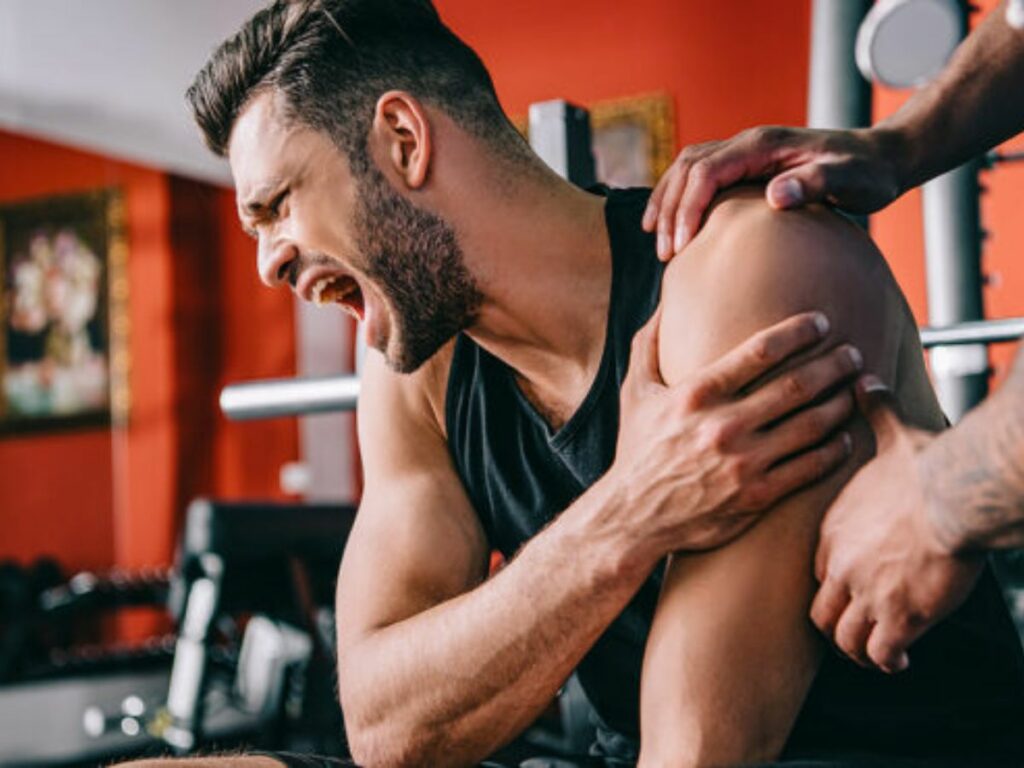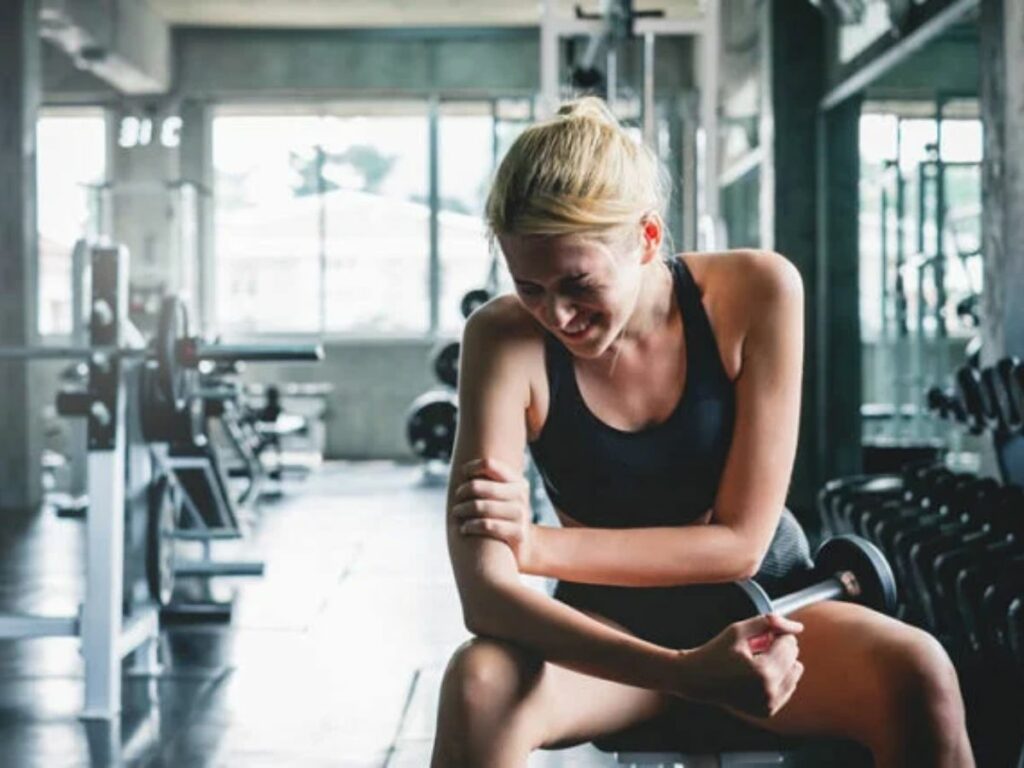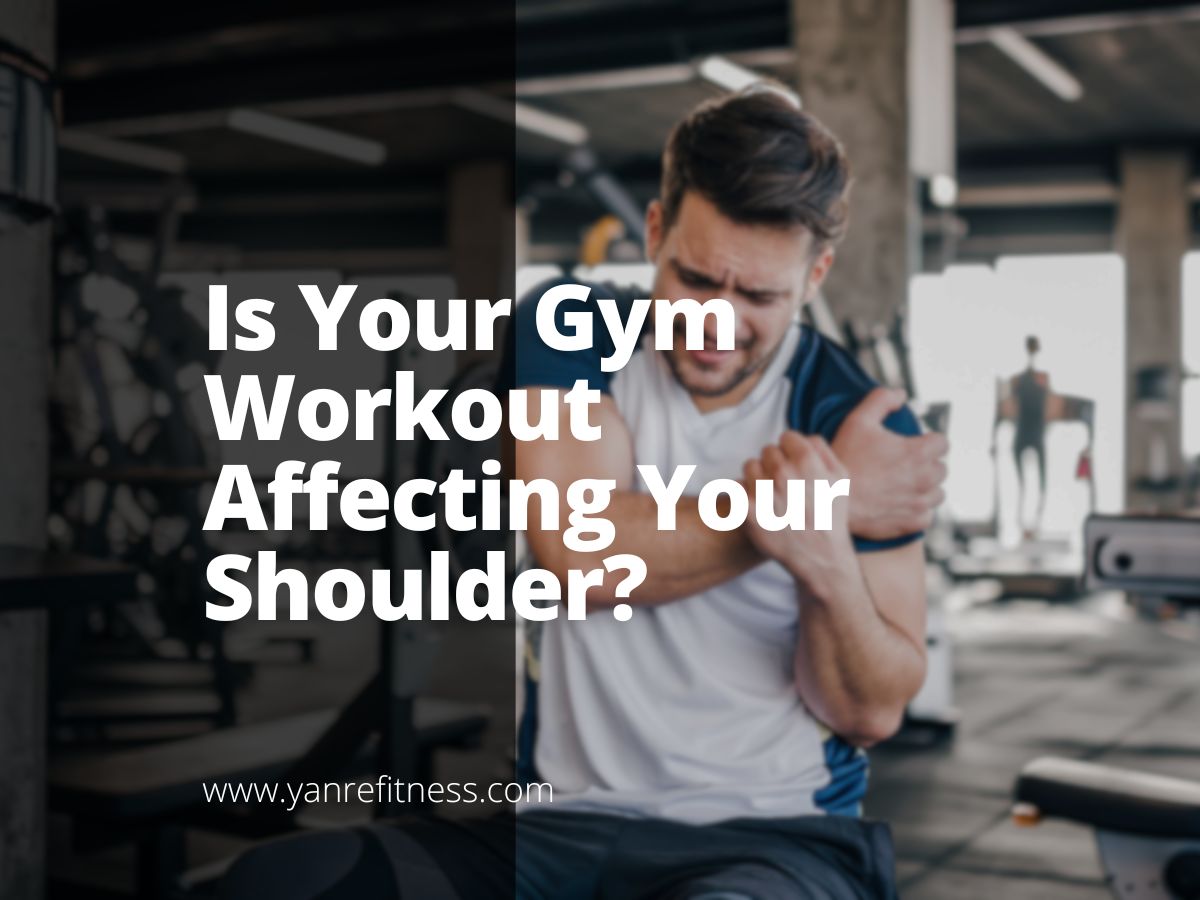Ever wondered if your workouts might be causing shoulder problems?
As someone deeply involved in fitness and gym activities, I’ve witnessed how workout routines can affect shoulder health.
This article checks if your gym routine harms your shoulder. We’ll find mistakes, see strain signs, and help you keep strong, pain-free shoulders.
If your shoulders ache after a workout, don’t worry. We’re here to help with practical tips to keep your shoulders healthy during your gym routine.
Stick with us as we show you how to keep your gym routine from hurting your shoulders.
Table of Contents
1. Anatomy of the Shoulder
Examine the complex shoulder structure, including bones and muscles, to enhance your workouts and prevent injuries in your fitness journey. Understanding this interplay is crucial, allowing you to customize exercises for better results and reduced risk of shoulder problems. Let’s delve deeper into this intricate anatomy to empower your fitness journey.
Shoulder Joint Structure
Explain the shoulder joint’s ball-and-socket structure, involving the humerus, scapula, and clavicle, emphasizing ligaments and tendons for stability in your workouts. This knowledge will help you perform exercises with confidence and reduce the risk of strain.
Muscle Anatomy
Gain insight into the deltoids, rotator cuff (supraspinatus, infraspinatus, teres minor, subscapularis), and trapezius to understand their roles in shoulder movement and exercise selection for effective shoulder workouts. This knowledge is invaluable for achieving well-rounded shoulder strength and stability.
Range of Motion
Enhancing shoulder flexibility, which involves flexion, extension, abduction, adduction, and rotation, is key for functional fitness and injury prevention during workouts. Incorporating exercises to boost these movements can enhance shoulder health and gym performance.
Common Shoulder Injuries
Discuss prevalent fitness-related shoulder issues like rotator cuff tears, impingement syndrome, and labral tears, offering prevention strategies and rehab exercises. After suffering an impingement, I’ve seen firsthand the value of prevention and rehab.
A solid grasp of shoulder anatomy is vital in the fitness realm. It not only optimizes workouts but also acts as a safeguard against injuries. Having personally faced a shoulder injury, I can’t stress enough how understanding shoulder anatomy directly impacts your fitness journey and overall well-being.
2. Common Mistakes That Lead to Shoulder Pain
This focuses on the importance of identifying exercise and daily routine errors that can result in shoulder pain and related issues. Recognizing these mistakes is not only vital for injury prevention but also for maintaining the long-term health and functionality of your shoulders. Now, let’s explore these common errors in more detail to help you safeguard your shoulder health.
Poor Posture
Poor posture, characterized by rounded shoulders and a forward head position, can cause undue stress on the shoulder joints and muscles, leading to discomfort and pain. For example, sitting hunched over a desk for extended periods can exacerbate these posture-related issues.
Overtraining
Overtraining your shoulders can cause ongoing pain, limit your ability to move your arm freely, and weaken your strength. It’s important to pay attention to your body and include rest days in your exercise routine.
Once, I pushed myself too hard in the gym, and it taught me a tough lesson about the dangers of overtraining. It’s essential to find the right balance in your fitness routine to keep your shoulders healthy and pain-free.
Lack of Mobility Work
Neglecting mobility exercises can lead to stiffness in the shoulder joint, reducing movement and increasing injury risk. Regular mobility routines improve range of motion, enhancing overall shoulder function and helping you maintain a pain-free fitness journey.
Improper Exercise Form
Using incorrect form during exercises such as overhead presses or bench presses can put undue stress on the shoulders, leading to strain or impingement injuries. To mitigate this risk, focus on proper technique and consider working with a fitness professional for guidance.
For shoulder health, it’s essential to maintain proper posture, practice controlled training, prioritize mobility, and ensure correct form during workouts. As someone who suffered from bad form, I took seriously the importance of avoiding such mistakes.

3. Signs and Symptoms of Shoulder Injury
Recognizing signs and sensations of shoulder injury is crucial, especially in fitness and sports, for early detection and effective management. When I missed the early signs once, I knew how critical it is to spot shoulder issues promptly. Let’s examine the key indicators of shoulder problems to ensure you can identify and address them proactively.

Pain
Pain, often characterized as a dull ache, sharp twinges, or constant discomfort, serves as a primary symptom of a shoulder injury, alerting individuals to potential issues and prompting further investigation. Recognizing these pain signals and addressing them promptly is crucial for preventing more severe shoulder problems.
Limited Range of Motion
Recognized by difficulty in moving the shoulder joint, such as raising or rotating the arm, indicating possible shoulder problems and the need for assessment to ensure optimal function. Seeking professional evaluation can help diagnose and address these mobility challenges effectively.
Weakness
Manifests as reduced strength and stability in the shoulder muscles, a common sign of injury that can impact performance, necessitating attention to prevent further complications. For instance, difficulty lifting weights that were once manageable may indicate such a reduction in strength and stability.
Swelling and Bruising
Observable signs of tissue damage, inflammation, or trauma in the shoulder area suggest the need for evaluation and care to address the underlying cause and facilitate the healing process. Ignoring these signs can lead to prolonged discomfort and potentially more severe injuries.
Quickly spotting shoulder injury signs is vital for getting timely treatment and recovering faster, so you can get back to your regular workouts sooner. My personal intake taught me that ignoring these early signs can disrupt your progress. It found the importance of staying aware and taking action early to ensure a smoother fitness journey and keep your shoulder healthy in the long run.
4. Recovery & Prevention
This topic covers strategies for recovering from and preventing shoulder injuries, vital for maintaining shoulder health in fitness and sports. Understanding these strategies aids in recovery and ongoing fitness pursuits. With that in mind, let’s explore these strategies in more detail to ensure your shoulder health remains optimal.
Rehabilitation Exercises
These exercises aid shoulder injury recovery by targeting the affected area to restore strength, flexibility, and motion range, reducing the risk of recurring issues. It’s important to perform them under the guidance of a qualified healthcare professional.
Preventive Measures
Actions like specific shoulder-strengthening exercises, proper technique, and maintaining good posture can help reduce the risk of future shoulder injuries. Incorporating these preventive measures into your fitness routine is essential for long-term shoulder health and injury prevention.
Nutrition and Recovery
Proper nutrition supports tissue repair, while adequate rest reduces overuse injury risk and enhances shoulder resilience. Through my healing process, I’ve observed the profound impact of nutrition and rested on repair and fortitude.
Holistic Shoulder Care
This approach considers physical therapy, rest, nutrition, and lifestyle choices as interconnected factors for optimal shoulder health and injury prevention. By addressing these facets holistically, individuals can ensure comprehensive care for their shoulders and reduce the likelihood of injuries.
These strategies help you recover from injuries and prevent future ones. They empower you to lead an active life without injuries getting in the way. I’ve seen these methods work, showing their consistent effectiveness in both injury recovery and maintaining an active lifestyle.

5. When to Seek Professional Help
Emphasizes the need to recognize when professional help is required for shoulder concerns in healthcare or fitness, which greatly affects management. Prompt consultation with an expert ensures tailored guidance for effective care. Now, let’s investigate in greater detail the significance of seeking professional guidance when facing shoulder concerns.
Persistent Pain or Discomfort
Persistent shoulder pain, even after sufficient rest and recovery, can be an indicator of an underlying issue that may necessitate professional assistance. Such discomfort can not only affect your daily life but also hinder your fitness progress.
Drawing from my personal experience, I understand the significance of recognizing when it’s essential to seek professional guidance and intervention for shoulder issues, as it can make a significant difference in your overall well-being and fitness journey.
Acute Injuries
Swift medical attention is crucial for sudden shoulder injuries like dislocations or fractures to prevent complications and ensure a proper recovery process. Ignoring these injuries can lead to setbacks, impacting your fitness goals and long-term shoulder health.
Progressive Weakness
Gradual shoulder muscle weakening calls for a professional evaluation to develop a customized plan for regaining strength and function, essential for an active lifestyle. Working with a professional ensures that your rehabilitation program aligns with your specific needs and goals.
Recognizing signs that indicate the need for professional assistance with shoulder issues is of paramount importance. These signs encompass ongoing pain, restricted mobility, sudden injuries, or a gradual decline in shoulder strength, all of which warrant early intervention for the sake of improved shoulder health.

6. 4 Tips to Prevent Shoulder Injuries During Workouts
This concise yet comprehensive guide is a valuable resource for all fitness enthusiasts, offering a wealth of actionable strategies and industry-relevant insights to proactively protect shoulder health by preventing injuries during workouts. Let’s uncover the fundamental approaches and valuable knowledge that can assist you in ensuring the well-being of your shoulders.
| Aspect | Tips to Prevent Shoulder Injuries During Workouts |
| Warm-Up | Always start with a thorough warm-up to increase blood flow and prepare the shoulder muscles for exercise. Include dynamic shoulder stretches. |
| Proper Form | Maintain proper exercise form throughout your workout to minimize strain on the shoulders. Focus on technique and control. |
| Shoulder Mobility and Flexibility | Incorporate shoulder mobility and flexibility exercises into your routine to improve range of motion and reduce the risk of injuries. |
| Gradual Progression | Progress slowly when increasing weight or intensity to avoid overloading the shoulder joints and muscles. |
| Balanced Workout Plan | Ensure a balanced workout plan that targets all major muscle groups, including the muscles that stabilize the shoulders. |
| Strengthening | Include exercises that strengthen the rotator cuff muscles, as well as the deltoids, traps, and rhomboids. |
| Rest and Recovery | Allow sufficient rest and recovery time between workouts to prevent overuse injuries. |
| Avoid Overhead Lifting | Be cautious with heavy overhead lifting, especially if you have a history of shoulder issues. |
| Listen to Your Body | Pay attention to any pain or discomfort in the shoulder area during exercises and stop immediately if you feel any unusual sensations. |
| Mobility Tools | Consider using mobility tools like foam rollers and lacrosse balls to release tension in the shoulder muscles. |
| Cross-Training | Engage in cross-training activities that vary the demands on the shoulders, reducing the risk of repetitive stress injuries. |
| Cooling Down | Conclude your workouts with static stretching and cool-down exercises to promote muscle recovery and flexibility. |
| Hydration and Nutrition | Stay hydrated and maintain a balanced diet to support overall muscle and joint health. |
| Professional Guidance | If you have a history of shoulder injuries or are unsure about your form, consult a fitness professional or physical therapist. |
| Equipment Check | Regularly inspect and maintain gym equipment to ensure safety during workouts. |
| Restorative Practices | Incorporate restorative practices like yoga or tai chi to promote shoulder health, flexibility, and relaxation. |
#1 Proper Warm-Up
This involves commencing your workout with gentle movements to gradually warm up your muscles and prepare your shoulders for more intensive exercises. I’ve consistently regarded this as a fundamental step in my own workout routine, as it plays a pivotal role in injury prevention and maintaining workout safety.
#2 Exercise Form and Technique
Pay attention to how you do exercises. Keep your posture right, move smoothly, and don’t push your joints too far. This lowers the chance of hurting your shoulders. Remember that proper technique is the foundation of injury prevention in your workouts.
#3 Gradual Progression
When you’re exercising, don’t rush to lift heavy weights or do tough workouts. Increase the challenge slowly. This helps your shoulder muscles and joints get stronger without getting hurt. Gradual progression is the key to sustained improvement in shoulder strength and resilience.
#4 Cross-Training and Variation
Try different exercises so you’re not doing the same movements all the time. This stops your shoulders from getting tired of doing one thing too much and reduces the chance of getting hurt. Incorporating variety in your fitness routine also keeps your workouts engaging and effective.
These essential tips help prevent workout injuries, making your exercise sessions safer and more effective. By following these rules carefully, you create a workout environment that reduces injury risk and enhances safety. Based on my fitness journey and strict adherence to these principles, I can confirm their crucial role in ensuring both safer and more successful workouts aligned with your fitness goals.
Conclusion
Make shoulder health your top priority to prevent injuries and attain sustainable fitness improvements. By adhering to this comprehensive guide, you’ll prepare the way for success in your fitness journey.
Always keep in mind that your shoulders serve as the foundation for upper body strength. Taking good care of them is most important as it will enable you to achieve your fitness objectives with confidence and sustainability.
Related articles:








